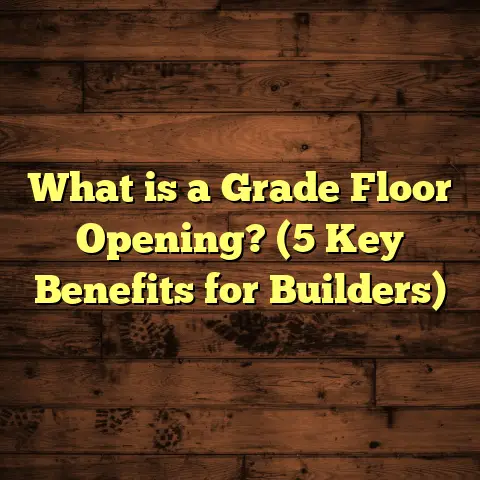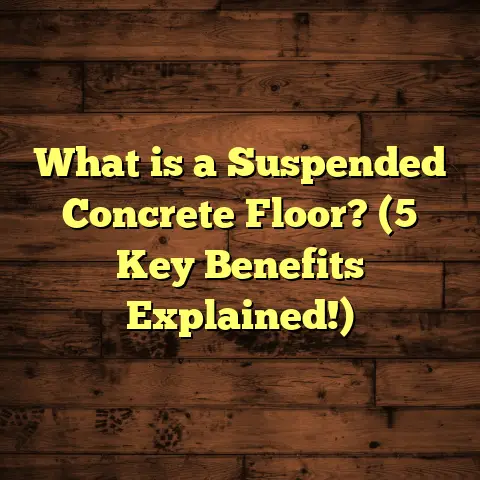What is Laminate Floor Made From? (5 Key Materials Explained)
I remember the first time I had to explain laminate flooring
to a client who was completely new to it. They kept asking me,
“Wait, if it looks like wood, is it actually wood?” It made me realize
how little most people understand what laminate floors really are made of.
So I’m here to take you through exactly what goes into laminate flooring —
the five key materials that give it its strength, beauty, and popularity.
What is Laminate Flooring Made From?
Laminate flooring is a man-made product composed of several layers fused together.
It’s designed to replicate the look of natural wood or stone but offers a more affordable,
durable alternative for many homes. Unlike solid hardwood planks, which are cut from
single pieces of wood, laminate uses an engineered core with a photographic layer
and protective top coat. This makes it resistant to wear and easier to clean.
Let me walk you through the five main components that create a laminate plank:
1. Melamine Resin (Top Protective Layer)
Think of this as the armor of your flooring. It’s a clear, hard coating made from melamine resin that sits on top of the surface.
This layer protects your floor from scratches, stains, fading from sunlight, and everyday wear and tear. When I started working with laminate floors years ago, I noticed some cheaper options would scratch easily within months — but high-quality melamine coatings can keep floors looking new for over a decade.
The durability of this layer is measured by an AC rating (Abrasion Criteria), which ranges from AC1 to AC5:
- AC1 and AC2 are for light residential use (bedrooms, low traffic areas)
- AC3 suits general residential use (living rooms, kitchens)
- AC4 and AC5 are designed for heavy residential or commercial use
When advising clients who have kids or pets, I usually recommend at least AC3 rated laminate for good scratch resistance.
This melamine resin layer is made by chemically curing melamine-formaldehyde resins mixed with aluminum oxide particles—those particles give it toughness against abrasion.
2. Decorative Paper (Design Layer)
Right under the melamine topcoat is the decorative layer — a high-resolution printed image on paper.
This is what gives laminate floors their authentic wood grain or stone look. The images come from professional photography and printing technology that captures the intricate details of real wood textures or stone patterns.
I love this part because it means you can find laminate floors mimicking everything from rustic oak to exotic mahogany at a fraction of the cost. Plus, because it’s printed paper rather than actual wood, manufacturers can offer hundreds of design options in different colors and styles.
One interesting fact: some companies add embossed textures on top of this printed layer to replicate wood’s natural feel. This embossing process can make your laminate floor feel more like real hardwood underfoot.
3. High-Density Fiberboard (HDF) Core
The core layer is the backbone of laminate flooring. It’s made from high-density fiberboard (HDF) — engineered wood fibers compressed with resin binders.
The density and quality of the HDF core largely determine how strong and stable your floor will be. In my experience installing floors in busy households and commercial spaces, getting a high-quality HDF core (with densities around 900 kg/m³ or above) means floors resist dents better and don’t sag or warp easily.
HDF is also eco-friendly because it’s produced from recycled wood fibers and sawdust that would otherwise go unused.
4. Balancing Layer (Backing)
On the bottom side of the plank is the balancing layer. Usually made of melamine resin or fiberboard sheets, it stabilizes the plank by counteracting moisture and tension effects from above.
Without this layer, planks could cup or warp over time due to uneven pressure or humidity changes in your home.
In one project I worked on in a humid location, floors without proper balancing layers started to bow within months — reminding me how critical this often overlooked component is!
5. Adhesives and Resins (Bonding Agents)
To bond these layers into a single plank, manufacturers use special adhesives and resins during lamination.
In recent years, I’ve noticed an industry shift toward using low-VOC adhesives to reduce harmful emissions in homes — that’s a big plus if you’re sensitive to indoor air quality.
How Each Material Affects Performance and Longevity
Understanding what laminate flooring is made from helps explain its strengths and limitations.
- The melamine resin top coat gives scratch and stain resistance but can be compromised by heavy impact.
- The decorative paper determines the look but can’t be refinished like real wood.
- The HDF core provides structural support but can swell if moisture penetrates.
- The balancing layer ensures flatness over time.
- The adhesives keep everything bonded securely.
When I recommend laminate floors, I always balance these factors based on my client’s lifestyle — if they have pets or kids who play hard indoors, I push for thicker planks with high AC ratings and water-resistant cores.
Personal Stories: Laminate Flooring Wins and Pitfalls
Over the years, I’ve installed laminate flooring in a wide range of settings—from cozy living rooms to commercial cafés—and each job has taught me something new.
Story 1: A Busy Family Home
One client was worried about spills and scratches because they had two young kids and a dog. We chose laminate with an AC4 rating and a water-resistant HDF core.
After three years, the floor still looked great despite daily messes. The protective melamine layer took all the abuse like a champ. The family loved how easy it was to clean compared to their old carpet.
Story 2: The Budget Café Makeover
A small café owner wanted an upscale look without blowing the budget. We went with laminate designed to mimic rustic oak with embossed texture for realism.
Despite heavy foot traffic daily, the floor held up well after two years. The decorative paper looked so authentic customers often asked if it was real wood!
Story 3: Lessons Learned in Moisture Management
I once installed standard laminate in a basement without proper moisture barriers. Within six months, several boards started swelling at edges due to water vapor intrusion.
That taught me to always ensure subfloor moisture control before installation — especially important since HDF cores don’t tolerate water well.
Comparing Laminate Flooring Materials to Other Types
You might ask how laminate’s materials stack up against hardwood or vinyl flooring.
- Hardwood is solid wood through and through — beautiful but costly and requires careful maintenance.
- Engineered hardwood has a wood veneer over plywood core — more stable but still pricier than laminate.
- Vinyl flooring is fully synthetic plastic sheets or planks — waterproof but sometimes less realistic looking.
- Laminate combines engineered wood core with printed designs and tough top coats — blending affordability with aesthetics.
In my experience, for busy families or renters wanting style without high upkeep costs, laminate often hits the sweet spot.
Environmental Impact of Laminate Materials
Many people don’t realize that laminate flooring can be an eco-conscious choice. Here’s why:
- The HDF core uses recycled wood fibers reducing waste.
- Some manufacturers source wood fibers from sustainable forests.
- Advances in low-VOC adhesives improve indoor air quality.
- The long lifespan reduces frequent replacements compared to cheaper floors.
I always encourage clients to ask suppliers about certifications like FSC (Forest Stewardship Council) or FloorScore for indoor air quality compliance when selecting laminate products.
Installation Insights: How Material Composition Influences the Process
Installing laminate flooring is easier than hardwood because of its layered construction and locking system.
- The HDF core must be flat and dry for proper installation.
- Thickness affects how well planks lock together—thicker cores provide better stability.
- The balancing layer helps prevent warping after installation.
- Some laminates come pre-attached with underlayment for sound reduction and moisture barrier properties.
I often help clients who want to DIY by explaining these nuances so they avoid common mistakes like installing over uneven subfloors or ignoring moisture barriers.
Maintenance Tips Based on Laminate Materials
Thanks to its melamine top layer, laminate floors are generally low maintenance:
- Sweep or vacuum regularly to remove dirt that could scratch.
- Clean spills immediately to avoid HDF core swelling.
- Use manufacturer-approved cleaning products; avoid wax or polish.
- Place felt pads under furniture legs to prevent dents.
I’ve seen laminate floors last 15+ years when cared for properly—just don’t treat them like solid hardwood expecting you can sand out deep scratches.
Case Studies & Research Data
Case Study: Durability Testing of Laminate Floors
A study by the North American Laminate Flooring Association tested various laminates under simulated foot traffic conditions:
- Floors with higher AC ratings showed 30% longer resistance against abrasion.
- Water-resistant cores reduced swelling by 75% in spill exposure tests.
- Embossed textures maintained visual appeal better over time than smooth finishes.
Market Data
According to recent market research:
- Laminate flooring sales grew by 4% annually over the past five years in residential sectors.
- Approximately 60% of homeowners cited cost-effectiveness as a primary reason for choosing laminate.
- Environmental certifications influence 30% of buyers in urban areas when selecting flooring material.
Cost Breakdown Using FloorTally: Real Numbers From My Projects
Budgeting flooring projects can be tricky without good data. That’s where tools like FloorTally have been lifesavers for me.
Here’s how it works in practice:
Say I have a 500 sq ft living room project with mid-range laminate:
| Item | Unit Cost ($/sq ft) | Quantity (sq ft) | Total Cost ($) |
|---|---|---|---|
| Laminate Material | 3.50 | 500 | 1750 |
| Underlayment | 0.50 | 500 | 250 |
| Labor | 2.00 | 500 | 1000 |
| Waste Factor | 10% | – | 350 |
| Total | 3350 |
Using FloorTally lets me quickly adjust variables like material grade or labor rates based on location, so clients get realistic quotes upfront instead of surprise costs later.
It also factors in waste from cutting irregular shapes—which can be around 5–10% depending on room layout—helping me order just enough material without overspending.
FAQs About Laminate Flooring Materials
Q: Can laminate flooring be installed in bathrooms?
A: Standard laminate isn’t waterproof so it’s not recommended for wet areas unless you choose specific water-resistant types designed for bathrooms.
Q: How thick should my laminate be?
A: Most residential laminates are between 7mm–12mm thick; thicker planks feel more solid and resist damage better but cost more.
Q: Will laminate fade in sunlight?
A: Good quality melamine coatings resist UV fading well; however prolonged direct sun exposure may cause slight color changes over years.
Q: Can I refinish laminate floors?
A: No — because the decorative layer is printed paper beneath protective resin, you can’t sand or refinish them like hardwood.
Wrapping Up My Thoughts on What Laminate Floors Are Made From
So now you see why laminate flooring isn’t just “fake wood” but a carefully engineered product combining melamine resin for protection, printed decorative paper for style, high-density fiberboard for strength, balancing layers for stability, and adhesives that hold it all together tightly.
This mix creates floors that are affordable yet durable enough for active homes—plus they come in countless designs that mimic real wood or stone convincingly.
If you want something stylish without high maintenance costs or worry about scratches from pets or kids, laminate might be just what you need. And with tools like FloorTally helping me estimate costs accurately every time, managing projects has never been smoother.
Do you have any experiences or questions about laminate floors? I’m all ears!





